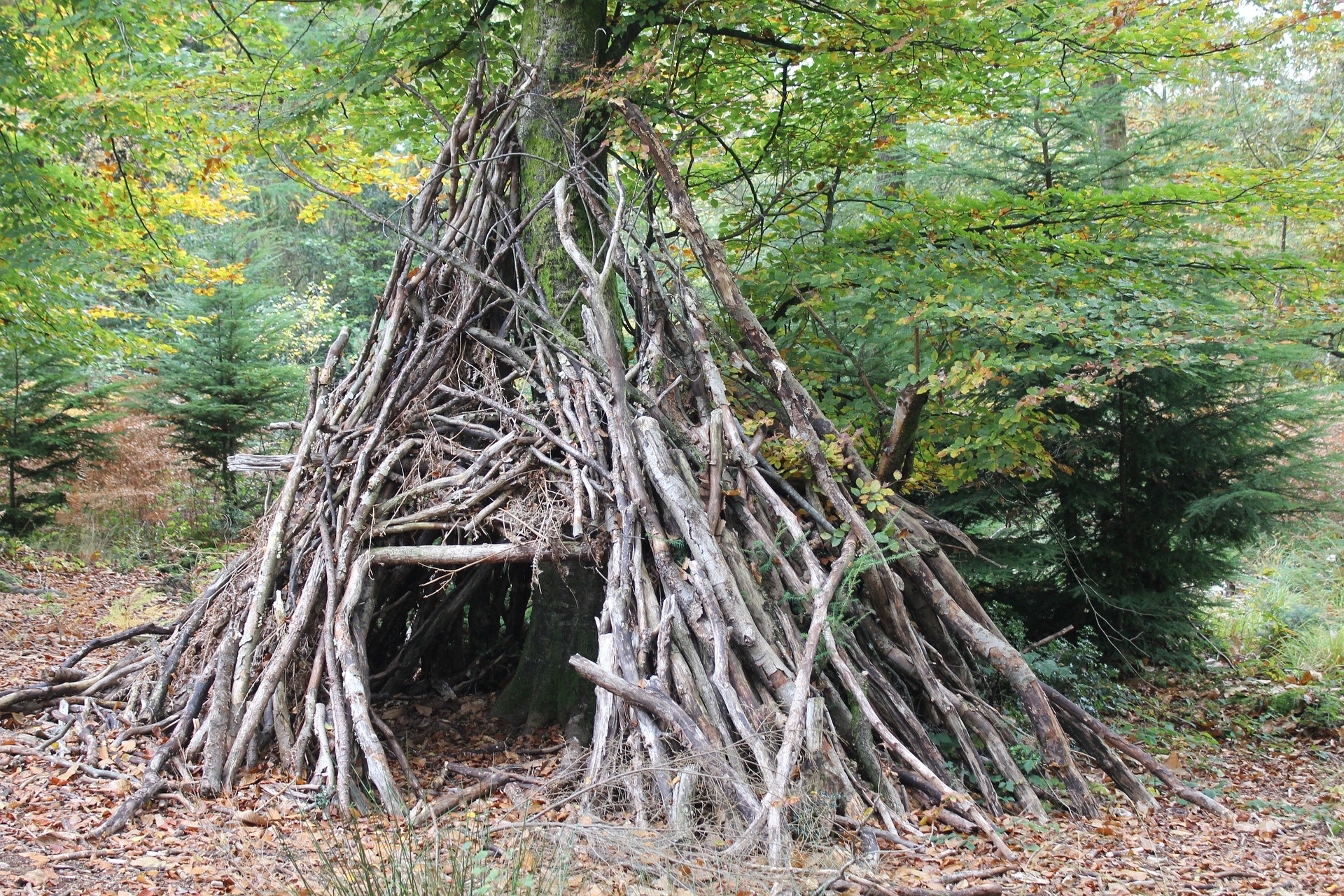A survival shelter serves to protect you from the elements, so it will look very different, depending on the environment. The appropriate size for a survival shelter will depend on the weather, number of people to be sheltered, and duration it is to be used. In northern climates where cold weather is the major obstacle, shelters should be just large enough to wriggle inside.
My experience is in the Upper Midwest, where cold temperatures are the largest threat. Every survival course I’ve given or received, the vast majority of students built shelters that were far too large and poorly insulated for our climate.
Shelters built for short-term warmth should be just large enough to fit the inhabitants all cuddled up, while longer-term shelters can be slowly expanded to enclose a slightly larger, more comfortable volume.
Table of Contents
Climate and Weather
The primary function of any shelter is to protect the inhabitants from the elements. Extreme heat, direct sunlight, precipitation, and wind are the main considerations.
The climate also controls the population of creepy-crawlies (spiders, snakes, scorpions, etc) which may influence shelter design as well.
Hot Climate Shelters
In hot climates, shelters are built more for shade than anything else. Given the varied angles of the sun throughout the day, a much larger footprint must be constructed to provide a reasonable stationary patch of shade.
Creepy-crawlies abound in the tropics, so getting up off the ground is desirable. A cot or hammock to stay off the wet, insect-infested soil is ideal.
Hot, humid areas have many large-leafed trees, excellent for the construction of a large waterproof roof. Many areas of the tropical world, rain is a daily and predictable occurrence, so you’ll need to plan a dry shelter, or spend a lot of time sopping wet.
Cold Climate Shelters
Cold and wet are the enemies in my area. The best way to stay warm and dry is thick insulation, and a good waterproofing layer.
Waterproofing is the toughest part. The easiest way is to build a shelter that is naturally tucked out of the wind and rain, but failing that, stacking pine boughs with the needles all pointing down is the next-best thing. This takes a lot of time and effort for a so-so result.
One thing it certainly pays to carry on your person whenever in the woods is a Mylar Thermal Blanket. They’re cheap and so lightweight you’ll forget you’re carrying them.
Mylar blankets are basically worthless as a blanket, as I found out by trying one on a pretty warm summer night, but they work wonders for waterproofing a shelter.
Build a very small debris hut frame out of sticks, just large enough to fit the inhabitants. Then toss the survival blanket over and lay a few more sticks to hold the blanket it place. Layer up as much insulation (leaves, twigs, pine boughs, or any other general forest debris) as you can get, and lock that in place with more large sticks over top.
In terms of insulation, we’re talking feet thick. To stay warm in the late autumn, before there’s snow around, I would aim for four feet thick of debris on my shelter.
Note: Snow is a much better insulator and can be substituted for the debris in a similar construction to improve performance.
This is why keeping the shelter as small as possible is absolutely critical. Gathering debris is energy-intensive, and in a survival situation, every bit of energy counts. Minimize the energy to build and heat your shelter, keep it tiny and cozy, like a burrow.
Shelter Group Size
The more people need to stay in a shelter, the larger it needs to be.
This means more material and effort to construct the shelter. It also means more hands to help build it, assuming everyone is in good health and able to participate.
Do not fall victim to the “fort-building mentality”. When people get into groups, the tendency is to overbuild. Group survival in cold climates involves lots of cuddling.
Get used to this idea, and build the shelter just big enough that you won’t step all over each other trying to get up to go to the bathroom at night. Try not to build too tall either, as that luxurious space will be paid for in extra materials and wasted body heat come night time.
Shelter Design Lifespan
The trouble with building a large, elaborate shelter is you end up with nowhere to sleep in the meanwhile.
Much like buying a plot of land to build your dream home and immediately selling off your existing house, shooting for a huge shelter off the bat will leave you very exposed.
The goal for the first night in any survival situation is to get enough of a shelter together to survive. In cold climates, this can be tricky enough on its own.
The most expedient shelter in northern forests is just crawling into a large leaf pile. A little more comfortable is a small debris-hut, which is basically that same leaf pile with a frame underneath to keep the weight of the leaves off you while you sleep.
Once you have something to keep you alive, then you can work on adding enough insulation to stay comfortably warm through the night.
The decision to build a large, long-term shelter needs to be carefully considered. People need to know that you’re missing, and where to look for you for sheltering in place to be the right strategy.
If staying put for a long time proves to be the right decision, then start by carefully planning a good spot for your large shelter, ideally near the supplies needed to build it.
Take your time, build it slow, and return to your short-term shelter each night until the larger, more permanent one is complete.
What Next?
If you’re headed into a situation or activity where surviving off the land may become necessary, make sure you brush up on my in-depth articles on Improvised Water Treatment and Primitive Fire Skills before you go.


